-
EXECUTIVE SUMMARY
-
1.1.
-
Market Overview
-
Key Findings
-
Market Segmentation
-
1.4.
-
Competitive Landscape
-
Challenges and Opportunities
-
Future
-
Outlook
-
MARKET INTRODUCTION
-
Definition
-
Scope of the study
- Research Objective
- Assumption
- Limitations
-
RESEARCH METHODOLOGY
-
Overview
-
3.2.
-
Data Mining
-
Secondary Research
-
Primary Research
- Breakdown of Primary
-
3.4.1.
-
Primary Interviews and Information Gathering Process
-
Respondents
-
Forecasting Model
-
Market Size Estimation
- Top-Down Approach
-
3.6.1.
-
Bottom-Up Approach
-
Data Triangulation
-
Validation
-
MARKET DYNAMICS
-
Overview
-
Drivers
-
Restraints
-
Opportunities
-
MARKET
-
FACTOR ANALYSIS
-
Value chain Analysis
-
Porter's Five Forces
- Bargaining Power of Suppliers
- Bargaining Power
- Threat of New Entrants
- Threat of Substitutes
- Intensity of Rivalry
-
Analysis
-
of Buyers
-
COVID-19 Impact Analysis
- Regional Impact
- Opportunity and
-
5.3.1.
-
Market Impact Analysis
-
Threat Analysis
-
AUTOMOTIVE AIRBAG INFLATOR MARKET, BY
-
TYPE (USD BILLION)
-
Chemical Airbag Inflators
-
Compressed Gas
-
Airbag Inflators
-
Hybrid Airbag Inflators
-
AUTOMOTIVE AIRBAG INFLATOR
-
MARKET, BY VEHICLE TYPE (USD BILLION)
-
Passenger Vehicles
-
Commercial
-
Vehicles
-
Motorcycles
-
AUTOMOTIVE AIRBAG INFLATOR MARKET, BY DEPLOYMENT
-
MODE (USD BILLION)
-
Single Stage
-
Multi Stage
-
AUTOMOTIVE
-
AIRBAG INFLATOR MARKET, BY AIRBAG TYPE (USD BILLION)
-
Frontal Airbags
-
Side Airbags
-
Curtain Airbags
-
AUTOMOTIVE AIRBAG INFLATOR
-
MARKET, BY REGIONAL (USD BILLION)
-
North America
- US
- Canada
-
Europe
- Germany
- UK
- Russia
- Italy
- Spain
-
10.2.3.
-
France
-
10.2.7.
-
Rest of Europe
-
APAC
- China
- India
- South Korea
- Malaysia
- Thailand
- Indonesia
- Rest of APAC
-
10.3.3.
-
Japan
-
South America
- Mexico
- Argentina
- Rest of South
-
10.4.1.
-
Brazil
-
America
-
MEA
- GCC Countries
- South Africa
- Rest of MEA
-
COMPETITIVE LANDSCAPE
-
11.1.
-
Overview
-
Competitive Analysis
-
Market share Analysis
-
Major Growth Strategy in the Automotive Airbag Inflator Market
-
11.5.
-
Competitive Benchmarking
-
Leading Players in Terms of Number of Developments
-
in the Automotive Airbag Inflator Market
-
Key developments and growth
- New Product Launch/Service Deployment
- Merger
- Joint Ventures
-
strategies
-
& Acquisitions
-
Major Players Financial
- Sales and Operating Income
- Major Players R&D
-
Matrix
-
Expenditure. 2023
-
COMPANY PROFILES
-
Takata
- Financial
- Products Offered
- Key Developments
- Key Strategies
-
Overview
-
12.1.4.
-
SWOT Analysis
-
East Japan Railway Company
- Financial Overview
- Products Offered
- Key
- SWOT Analysis
- Key Strategies
- Financial Overview
- Products Offered
- SWOT Analysis
- Key Strategies
- Financial Overview
- Products Offered
- Key Developments
- SWOT Analysis
- Key Strategies
-
Developments
-
12.3.
-
Autoliv
-
12.3.3.
-
Key Developments
-
12.4.
-
Daicel Corporation
-
Continental
- Financial Overview
- Products
- Key Developments
- SWOT Analysis
-
Offered
-
12.5.5.
-
Key Strategies
-
Honeywell
- Financial Overview
- Key Developments
- SWOT Analysis
- Key Strategies
-
12.6.2.
-
Products Offered
-
KSS
- Financial Overview
- Key Developments
- SWOT Analysis
- Key Strategies
-
12.7.2.
-
Products Offered
-
Joyson Safety Systems
- Financial
- Products Offered
- Key Developments
- Key Strategies
-
Overview
-
12.8.4.
-
SWOT Analysis
-
SABAN
- Financial
- Products Offered
- Key Developments
- Key Strategies
-
Overview
-
12.9.4.
-
SWOT Analysis
-
Shanghai Potevio
- Products Offered
- Key Developments
- SWOT Analysis
- Key Strategies
-
12.10.1.
-
Financial Overview
-
Zhejiang
- Financial Overview
- Products Offered
- Key Developments
- SWOT Analysis
- Key
-
Jialong Technology
-
Strategies
-
Ashimori Industry
- Financial Overview
- Products Offered
- Key Developments
- SWOT
- Key Strategies
-
Analysis
-
Aisin Seiki
- Financial
- Products Offered
- Key Developments
- Key Strategies
-
Overview
-
12.13.4.
-
SWOT Analysis
-
TRW Automotive
- Products Offered
- Key Developments
- SWOT Analysis
- Key Strategies
-
12.14.1.
-
Financial Overview
-
Nisshinbo
- Financial Overview
- Products Offered
- SWOT Analysis
- Key Strategies
-
Holdings
-
12.15.3.
-
Key Developments
-
APPENDIX
-
References
-
Related Reports
-
LIST OF
-
TABLES
-
LIST OF ASSUMPTIONS
-
NORTH AMERICA AUTOMOTIVE
-
AIRBAG INFLATOR MARKET SIZE ESTIMATES & FORECAST, BY TYPE, 2019-2032 (USD BILLIONS)
-
NORTH AMERICA AUTOMOTIVE AIRBAG INFLATOR MARKET SIZE ESTIMATES &
-
FORECAST, BY VEHICLE TYPE, 2019-2032 (USD BILLIONS)
-
NORTH AMERICA
-
AUTOMOTIVE AIRBAG INFLATOR MARKET SIZE ESTIMATES & FORECAST, BY DEPLOYMENT MODE,
-
NORTH AMERICA AUTOMOTIVE AIRBAG INFLATOR
-
MARKET SIZE ESTIMATES & FORECAST, BY AIRBAG TYPE, 2019-2032 (USD BILLIONS)
-
NORTH AMERICA AUTOMOTIVE AIRBAG INFLATOR MARKET SIZE ESTIMATES &
-
FORECAST, BY REGIONAL, 2019-2032 (USD BILLIONS)
-
US AUTOMOTIVE AIRBAG
-
INFLATOR MARKET SIZE ESTIMATES & FORECAST, BY TYPE, 2019-2032 (USD BILLIONS)
-
US AUTOMOTIVE AIRBAG INFLATOR MARKET SIZE ESTIMATES & FORECAST,
-
BY VEHICLE TYPE, 2019-2032 (USD BILLIONS)
-
US AUTOMOTIVE AIRBAG INFLATOR
-
MARKET SIZE ESTIMATES & FORECAST, BY DEPLOYMENT MODE, 2019-2032 (USD BILLIONS)
-
US AUTOMOTIVE AIRBAG INFLATOR MARKET SIZE ESTIMATES & FORECAST,
-
BY AIRBAG TYPE, 2019-2032 (USD BILLIONS)
-
US AUTOMOTIVE AIRBAG INFLATOR
-
MARKET SIZE ESTIMATES & FORECAST, BY REGIONAL, 2019-2032 (USD BILLIONS)
-
CANADA AUTOMOTIVE AIRBAG INFLATOR MARKET SIZE ESTIMATES & FORECAST,
-
BY TYPE, 2019-2032 (USD BILLIONS)
-
CANADA AUTOMOTIVE AIRBAG INFLATOR
-
MARKET SIZE ESTIMATES & FORECAST, BY VEHICLE TYPE, 2019-2032 (USD BILLIONS)
-
CANADA AUTOMOTIVE AIRBAG INFLATOR MARKET SIZE ESTIMATES & FORECAST,
-
BY DEPLOYMENT MODE, 2019-2032 (USD BILLIONS)
-
CANADA AUTOMOTIVE AIRBAG
-
INFLATOR MARKET SIZE ESTIMATES & FORECAST, BY AIRBAG TYPE, 2019-2032 (USD BILLIONS)
-
CANADA AUTOMOTIVE AIRBAG INFLATOR MARKET SIZE ESTIMATES & FORECAST,
-
BY REGIONAL, 2019-2032 (USD BILLIONS)
-
EUROPE AUTOMOTIVE AIRBAG INFLATOR
-
MARKET SIZE ESTIMATES & FORECAST, BY TYPE, 2019-2032 (USD BILLIONS)
-
TABLE
-
EUROPE AUTOMOTIVE AIRBAG INFLATOR MARKET SIZE ESTIMATES & FORECAST, BY VEHICLE
-
TYPE, 2019-2032 (USD BILLIONS)
-
EUROPE AUTOMOTIVE AIRBAG INFLATOR
-
MARKET SIZE ESTIMATES & FORECAST, BY DEPLOYMENT MODE, 2019-2032 (USD BILLIONS)
-
EUROPE AUTOMOTIVE AIRBAG INFLATOR MARKET SIZE ESTIMATES & FORECAST,
-
BY AIRBAG TYPE, 2019-2032 (USD BILLIONS)
-
EUROPE AUTOMOTIVE AIRBAG
-
INFLATOR MARKET SIZE ESTIMATES & FORECAST, BY REGIONAL, 2019-2032 (USD BILLIONS)
-
GERMANY AUTOMOTIVE AIRBAG INFLATOR MARKET SIZE ESTIMATES & FORECAST,
-
BY TYPE, 2019-2032 (USD BILLIONS)
-
GERMANY AUTOMOTIVE AIRBAG INFLATOR
-
MARKET SIZE ESTIMATES & FORECAST, BY VEHICLE TYPE, 2019-2032 (USD BILLIONS)
-
GERMANY AUTOMOTIVE AIRBAG INFLATOR MARKET SIZE ESTIMATES & FORECAST,
-
BY DEPLOYMENT MODE, 2019-2032 (USD BILLIONS)
-
GERMANY AUTOMOTIVE
-
AIRBAG INFLATOR MARKET SIZE ESTIMATES & FORECAST, BY AIRBAG TYPE, 2019-2032
-
(USD BILLIONS)
-
GERMANY AUTOMOTIVE AIRBAG INFLATOR MARKET SIZE ESTIMATES
-
& FORECAST, BY REGIONAL, 2019-2032 (USD BILLIONS)
-
UK AUTOMOTIVE
-
AIRBAG INFLATOR MARKET SIZE ESTIMATES & FORECAST, BY TYPE, 2019-2032 (USD BILLIONS)
-
UK AUTOMOTIVE AIRBAG INFLATOR MARKET SIZE ESTIMATES & FORECAST,
-
BY VEHICLE TYPE, 2019-2032 (USD BILLIONS)
-
UK AUTOMOTIVE AIRBAG INFLATOR
-
MARKET SIZE ESTIMATES & FORECAST, BY DEPLOYMENT MODE, 2019-2032 (USD BILLIONS)
-
UK AUTOMOTIVE AIRBAG INFLATOR MARKET SIZE ESTIMATES & FORECAST,
-
BY AIRBAG TYPE, 2019-2032 (USD BILLIONS)
-
UK AUTOMOTIVE AIRBAG INFLATOR
-
MARKET SIZE ESTIMATES & FORECAST, BY REGIONAL, 2019-2032 (USD BILLIONS)
-
FRANCE AUTOMOTIVE AIRBAG INFLATOR MARKET SIZE ESTIMATES & FORECAST,
-
BY TYPE, 2019-2032 (USD BILLIONS)
-
FRANCE AUTOMOTIVE AIRBAG INFLATOR
-
MARKET SIZE ESTIMATES & FORECAST, BY VEHICLE TYPE, 2019-2032 (USD BILLIONS)
-
FRANCE AUTOMOTIVE AIRBAG INFLATOR MARKET SIZE ESTIMATES & FORECAST,
-
BY DEPLOYMENT MODE, 2019-2032 (USD BILLIONS)
-
FRANCE AUTOMOTIVE AIRBAG
-
INFLATOR MARKET SIZE ESTIMATES & FORECAST, BY AIRBAG TYPE, 2019-2032 (USD BILLIONS)
-
FRANCE AUTOMOTIVE AIRBAG INFLATOR MARKET SIZE ESTIMATES & FORECAST,
-
BY REGIONAL, 2019-2032 (USD BILLIONS)
-
RUSSIA AUTOMOTIVE AIRBAG INFLATOR
-
MARKET SIZE ESTIMATES & FORECAST, BY TYPE, 2019-2032 (USD BILLIONS)
-
TABLE
-
RUSSIA AUTOMOTIVE AIRBAG INFLATOR MARKET SIZE ESTIMATES & FORECAST, BY VEHICLE
-
TYPE, 2019-2032 (USD BILLIONS)
-
RUSSIA AUTOMOTIVE AIRBAG INFLATOR
-
MARKET SIZE ESTIMATES & FORECAST, BY DEPLOYMENT MODE, 2019-2032 (USD BILLIONS)
-
RUSSIA AUTOMOTIVE AIRBAG INFLATOR MARKET SIZE ESTIMATES & FORECAST,
-
BY AIRBAG TYPE, 2019-2032 (USD BILLIONS)
-
RUSSIA AUTOMOTIVE AIRBAG
-
INFLATOR MARKET SIZE ESTIMATES & FORECAST, BY REGIONAL, 2019-2032 (USD BILLIONS)
-
ITALY AUTOMOTIVE AIRBAG INFLATOR MARKET SIZE ESTIMATES & FORECAST,
-
BY TYPE, 2019-2032 (USD BILLIONS)
-
ITALY AUTOMOTIVE AIRBAG INFLATOR
-
MARKET SIZE ESTIMATES & FORECAST, BY VEHICLE TYPE, 2019-2032 (USD BILLIONS)
-
ITALY AUTOMOTIVE AIRBAG INFLATOR MARKET SIZE ESTIMATES & FORECAST,
-
BY DEPLOYMENT MODE, 2019-2032 (USD BILLIONS)
-
ITALY AUTOMOTIVE AIRBAG
-
INFLATOR MARKET SIZE ESTIMATES & FORECAST, BY AIRBAG TYPE, 2019-2032 (USD BILLIONS)
-
ITALY AUTOMOTIVE AIRBAG INFLATOR MARKET SIZE ESTIMATES & FORECAST,
-
BY REGIONAL, 2019-2032 (USD BILLIONS)
-
SPAIN AUTOMOTIVE AIRBAG INFLATOR
-
MARKET SIZE ESTIMATES & FORECAST, BY TYPE, 2019-2032 (USD BILLIONS)
-
TABLE
-
SPAIN AUTOMOTIVE AIRBAG INFLATOR MARKET SIZE ESTIMATES & FORECAST, BY VEHICLE
-
TYPE, 2019-2032 (USD BILLIONS)
-
SPAIN AUTOMOTIVE AIRBAG INFLATOR
-
MARKET SIZE ESTIMATES & FORECAST, BY DEPLOYMENT MODE, 2019-2032 (USD BILLIONS)
-
SPAIN AUTOMOTIVE AIRBAG INFLATOR MARKET SIZE ESTIMATES & FORECAST,
-
BY AIRBAG TYPE, 2019-2032 (USD BILLIONS)
-
SPAIN AUTOMOTIVE AIRBAG
-
INFLATOR MARKET SIZE ESTIMATES & FORECAST, BY REGIONAL, 2019-2032 (USD BILLIONS)
-
REST OF EUROPE AUTOMOTIVE AIRBAG INFLATOR MARKET SIZE ESTIMATES
-
& FORECAST, BY TYPE, 2019-2032 (USD BILLIONS)
-
REST OF EUROPE
-
AUTOMOTIVE AIRBAG INFLATOR MARKET SIZE ESTIMATES & FORECAST, BY VEHICLE TYPE,
-
REST OF EUROPE AUTOMOTIVE AIRBAG INFLATOR
-
MARKET SIZE ESTIMATES & FORECAST, BY DEPLOYMENT MODE, 2019-2032 (USD BILLIONS)
-
REST OF EUROPE AUTOMOTIVE AIRBAG INFLATOR MARKET SIZE ESTIMATES
-
& FORECAST, BY AIRBAG TYPE, 2019-2032 (USD BILLIONS)
-
REST OF
-
EUROPE AUTOMOTIVE AIRBAG INFLATOR MARKET SIZE ESTIMATES & FORECAST, BY REGIONAL,
-
APAC AUTOMOTIVE AIRBAG INFLATOR MARKET
-
SIZE ESTIMATES & FORECAST, BY TYPE, 2019-2032 (USD BILLIONS)
-
TABLE 58.
-
APAC AUTOMOTIVE AIRBAG INFLATOR MARKET SIZE ESTIMATES & FORECAST, BY VEHICLE
-
TYPE, 2019-2032 (USD BILLIONS)
-
APAC AUTOMOTIVE AIRBAG INFLATOR MARKET
-
SIZE ESTIMATES & FORECAST, BY DEPLOYMENT MODE, 2019-2032 (USD BILLIONS)
-
APAC AUTOMOTIVE AIRBAG INFLATOR MARKET SIZE ESTIMATES & FORECAST,
-
BY AIRBAG TYPE, 2019-2032 (USD BILLIONS)
-
APAC AUTOMOTIVE AIRBAG
-
INFLATOR MARKET SIZE ESTIMATES & FORECAST, BY REGIONAL, 2019-2032 (USD BILLIONS)
-
CHINA AUTOMOTIVE AIRBAG INFLATOR MARKET SIZE ESTIMATES & FORECAST,
-
BY TYPE, 2019-2032 (USD BILLIONS)
-
CHINA AUTOMOTIVE AIRBAG INFLATOR
-
MARKET SIZE ESTIMATES & FORECAST, BY VEHICLE TYPE, 2019-2032 (USD BILLIONS)
-
CHINA AUTOMOTIVE AIRBAG INFLATOR MARKET SIZE ESTIMATES & FORECAST,
-
BY DEPLOYMENT MODE, 2019-2032 (USD BILLIONS)
-
CHINA AUTOMOTIVE AIRBAG
-
INFLATOR MARKET SIZE ESTIMATES & FORECAST, BY AIRBAG TYPE, 2019-2032 (USD BILLIONS)
-
CHINA AUTOMOTIVE AIRBAG INFLATOR MARKET SIZE ESTIMATES & FORECAST,
-
BY REGIONAL, 2019-2032 (USD BILLIONS)
-
INDIA AUTOMOTIVE AIRBAG INFLATOR
-
MARKET SIZE ESTIMATES & FORECAST, BY TYPE, 2019-2032 (USD BILLIONS)
-
TABLE
-
INDIA AUTOMOTIVE AIRBAG INFLATOR MARKET SIZE ESTIMATES & FORECAST, BY VEHICLE
-
TYPE, 2019-2032 (USD BILLIONS)
-
INDIA AUTOMOTIVE AIRBAG INFLATOR
-
MARKET SIZE ESTIMATES & FORECAST, BY DEPLOYMENT MODE, 2019-2032 (USD BILLIONS)
-
INDIA AUTOMOTIVE AIRBAG INFLATOR MARKET SIZE ESTIMATES & FORECAST,
-
BY AIRBAG TYPE, 2019-2032 (USD BILLIONS)
-
INDIA AUTOMOTIVE AIRBAG
-
INFLATOR MARKET SIZE ESTIMATES & FORECAST, BY REGIONAL, 2019-2032 (USD BILLIONS)
-
JAPAN AUTOMOTIVE AIRBAG INFLATOR MARKET SIZE ESTIMATES & FORECAST,
-
BY TYPE, 2019-2032 (USD BILLIONS)
-
JAPAN AUTOMOTIVE AIRBAG INFLATOR
-
MARKET SIZE ESTIMATES & FORECAST, BY VEHICLE TYPE, 2019-2032 (USD BILLIONS)
-
JAPAN AUTOMOTIVE AIRBAG INFLATOR MARKET SIZE ESTIMATES & FORECAST,
-
BY DEPLOYMENT MODE, 2019-2032 (USD BILLIONS)
-
JAPAN AUTOMOTIVE AIRBAG
-
INFLATOR MARKET SIZE ESTIMATES & FORECAST, BY AIRBAG TYPE, 2019-2032 (USD BILLIONS)
-
JAPAN AUTOMOTIVE AIRBAG INFLATOR MARKET SIZE ESTIMATES & FORECAST,
-
BY REGIONAL, 2019-2032 (USD BILLIONS)
-
SOUTH KOREA AUTOMOTIVE AIRBAG
-
INFLATOR MARKET SIZE ESTIMATES & FORECAST, BY TYPE, 2019-2032 (USD BILLIONS)
-
SOUTH KOREA AUTOMOTIVE AIRBAG INFLATOR MARKET SIZE ESTIMATES &
-
FORECAST, BY VEHICLE TYPE, 2019-2032 (USD BILLIONS)
-
SOUTH KOREA
-
AUTOMOTIVE AIRBAG INFLATOR MARKET SIZE ESTIMATES & FORECAST, BY DEPLOYMENT MODE,
-
SOUTH KOREA AUTOMOTIVE AIRBAG INFLATOR
-
MARKET SIZE ESTIMATES & FORECAST, BY AIRBAG TYPE, 2019-2032 (USD BILLIONS)
-
SOUTH KOREA AUTOMOTIVE AIRBAG INFLATOR MARKET SIZE ESTIMATES & FORECAST,
-
BY REGIONAL, 2019-2032 (USD BILLIONS)
-
MALAYSIA AUTOMOTIVE AIRBAG
-
INFLATOR MARKET SIZE ESTIMATES & FORECAST, BY TYPE, 2019-2032 (USD BILLIONS)
-
MALAYSIA AUTOMOTIVE AIRBAG INFLATOR MARKET SIZE ESTIMATES &
-
FORECAST, BY VEHICLE TYPE, 2019-2032 (USD BILLIONS)
-
MALAYSIA AUTOMOTIVE
-
AIRBAG INFLATOR MARKET SIZE ESTIMATES & FORECAST, BY DEPLOYMENT MODE, 2019-2032
-
(USD BILLIONS)
-
MALAYSIA AUTOMOTIVE AIRBAG INFLATOR MARKET SIZE ESTIMATES
-
& FORECAST, BY AIRBAG TYPE, 2019-2032 (USD BILLIONS)
-
MALAYSIA
-
AUTOMOTIVE AIRBAG INFLATOR MARKET SIZE ESTIMATES & FORECAST, BY REGIONAL, 2019-2032
-
(USD BILLIONS)
-
THAILAND AUTOMOTIVE AIRBAG INFLATOR MARKET SIZE ESTIMATES
-
& FORECAST, BY TYPE, 2019-2032 (USD BILLIONS)
-
THAILAND AUTOMOTIVE
-
AIRBAG INFLATOR MARKET SIZE ESTIMATES & FORECAST, BY VEHICLE TYPE, 2019-2032
-
(USD BILLIONS)
-
THAILAND AUTOMOTIVE AIRBAG INFLATOR MARKET SIZE ESTIMATES
-
& FORECAST, BY DEPLOYMENT MODE, 2019-2032 (USD BILLIONS)
-
THAILAND
-
AUTOMOTIVE AIRBAG INFLATOR MARKET SIZE ESTIMATES & FORECAST, BY AIRBAG TYPE,
-
THAILAND AUTOMOTIVE AIRBAG INFLATOR MARKET
-
SIZE ESTIMATES & FORECAST, BY REGIONAL, 2019-2032 (USD BILLIONS)
-
TABLE
-
INDONESIA AUTOMOTIVE AIRBAG INFLATOR MARKET SIZE ESTIMATES & FORECAST, BY
-
TYPE, 2019-2032 (USD BILLIONS)
-
INDONESIA AUTOMOTIVE AIRBAG INFLATOR
-
MARKET SIZE ESTIMATES & FORECAST, BY VEHICLE TYPE, 2019-2032 (USD BILLIONS)
-
INDONESIA AUTOMOTIVE AIRBAG INFLATOR MARKET SIZE ESTIMATES &
-
FORECAST, BY DEPLOYMENT MODE, 2019-2032 (USD BILLIONS)
-
INDONESIA
-
AUTOMOTIVE AIRBAG INFLATOR MARKET SIZE ESTIMATES & FORECAST, BY AIRBAG TYPE,
-
INDONESIA AUTOMOTIVE AIRBAG INFLATOR MARKET
-
SIZE ESTIMATES & FORECAST, BY REGIONAL, 2019-2032 (USD BILLIONS)
-
TABLE
-
REST OF APAC AUTOMOTIVE AIRBAG INFLATOR MARKET SIZE ESTIMATES & FORECAST,
-
BY TYPE, 2019-2032 (USD BILLIONS)
-
REST OF APAC AUTOMOTIVE AIRBAG
-
INFLATOR MARKET SIZE ESTIMATES & FORECAST, BY VEHICLE TYPE, 2019-2032 (USD BILLIONS)
-
REST OF APAC AUTOMOTIVE AIRBAG INFLATOR MARKET SIZE ESTIMATES &
-
FORECAST, BY DEPLOYMENT MODE, 2019-2032 (USD BILLIONS)
-
REST OF
-
APAC AUTOMOTIVE AIRBAG INFLATOR MARKET SIZE ESTIMATES & FORECAST, BY AIRBAG
-
TYPE, 2019-2032 (USD BILLIONS)
-
REST OF APAC AUTOMOTIVE AIRBAG INFLATOR
-
MARKET SIZE ESTIMATES & FORECAST, BY REGIONAL, 2019-2032 (USD BILLIONS)
-
SOUTH AMERICA AUTOMOTIVE AIRBAG INFLATOR MARKET SIZE ESTIMATES &
-
FORECAST, BY TYPE, 2019-2032 (USD BILLIONS)
-
SOUTH AMERICA AUTOMOTIVE
-
AIRBAG INFLATOR MARKET SIZE ESTIMATES & FORECAST, BY VEHICLE TYPE, 2019-2032
-
(USD BILLIONS)
-
SOUTH AMERICA AUTOMOTIVE AIRBAG INFLATOR MARKET
-
SIZE ESTIMATES & FORECAST, BY DEPLOYMENT MODE, 2019-2032 (USD BILLIONS)
-
SOUTH AMERICA AUTOMOTIVE AIRBAG INFLATOR MARKET SIZE ESTIMATES &
-
FORECAST, BY AIRBAG TYPE, 2019-2032 (USD BILLIONS)
-
SOUTH AMERICA
-
AUTOMOTIVE AIRBAG INFLATOR MARKET SIZE ESTIMATES & FORECAST, BY REGIONAL, 2019-2032
-
(USD BILLIONS)
-
BRAZIL AUTOMOTIVE AIRBAG INFLATOR MARKET SIZE ESTIMATES
-
& FORECAST, BY TYPE, 2019-2032 (USD BILLIONS)
-
BRAZIL AUTOMOTIVE
-
AIRBAG INFLATOR MARKET SIZE ESTIMATES & FORECAST, BY VEHICLE TYPE, 2019-2032
-
(USD BILLIONS)
-
BRAZIL AUTOMOTIVE AIRBAG INFLATOR MARKET SIZE ESTIMATES
-
& FORECAST, BY DEPLOYMENT MODE, 2019-2032 (USD BILLIONS)
-
BRAZIL
-
AUTOMOTIVE AIRBAG INFLATOR MARKET SIZE ESTIMATES & FORECAST, BY AIRBAG TYPE,
-
BRAZIL AUTOMOTIVE AIRBAG INFLATOR MARKET
-
SIZE ESTIMATES & FORECAST, BY REGIONAL, 2019-2032 (USD BILLIONS)
-
TABLE
-
MEXICO AUTOMOTIVE AIRBAG INFLATOR MARKET SIZE ESTIMATES & FORECAST, BY
-
TYPE, 2019-2032 (USD BILLIONS)
-
MEXICO AUTOMOTIVE AIRBAG INFLATOR
-
MARKET SIZE ESTIMATES & FORECAST, BY VEHICLE TYPE, 2019-2032 (USD BILLIONS)
-
MEXICO AUTOMOTIVE AIRBAG INFLATOR MARKET SIZE ESTIMATES & FORECAST,
-
BY DEPLOYMENT MODE, 2019-2032 (USD BILLIONS)
-
MEXICO AUTOMOTIVE
-
AIRBAG INFLATOR MARKET SIZE ESTIMATES & FORECAST, BY AIRBAG TYPE, 2019-2032
-
(USD BILLIONS)
-
MEXICO AUTOMOTIVE AIRBAG INFLATOR MARKET SIZE ESTIMATES
-
& FORECAST, BY REGIONAL, 2019-2032 (USD BILLIONS)
-
ARGENTINA
-
AUTOMOTIVE AIRBAG INFLATOR MARKET SIZE ESTIMATES & FORECAST, BY TYPE, 2019-2032
-
(USD BILLIONS)
-
ARGENTINA AUTOMOTIVE AIRBAG INFLATOR MARKET SIZE
-
ESTIMATES & FORECAST, BY VEHICLE TYPE, 2019-2032 (USD BILLIONS)
-
TABLE
-
ARGENTINA AUTOMOTIVE AIRBAG INFLATOR MARKET SIZE ESTIMATES & FORECAST,
-
BY DEPLOYMENT MODE, 2019-2032 (USD BILLIONS)
-
ARGENTINA AUTOMOTIVE
-
AIRBAG INFLATOR MARKET SIZE ESTIMATES & FORECAST, BY AIRBAG TYPE, 2019-2032
-
(USD BILLIONS)
-
ARGENTINA AUTOMOTIVE AIRBAG INFLATOR MARKET SIZE
-
ESTIMATES & FORECAST, BY REGIONAL, 2019-2032 (USD BILLIONS)
-
TABLE 122.
-
REST OF SOUTH AMERICA AUTOMOTIVE AIRBAG INFLATOR MARKET SIZE ESTIMATES & FORECAST,
-
BY TYPE, 2019-2032 (USD BILLIONS)
-
REST OF SOUTH AMERICA AUTOMOTIVE
-
AIRBAG INFLATOR MARKET SIZE ESTIMATES & FORECAST, BY VEHICLE TYPE, 2019-2032
-
(USD BILLIONS)
-
REST OF SOUTH AMERICA AUTOMOTIVE AIRBAG INFLATOR
-
MARKET SIZE ESTIMATES & FORECAST, BY DEPLOYMENT MODE, 2019-2032 (USD BILLIONS)
-
REST OF SOUTH AMERICA AUTOMOTIVE AIRBAG INFLATOR MARKET SIZE ESTIMATES
-
& FORECAST, BY AIRBAG TYPE, 2019-2032 (USD BILLIONS)
-
REST OF
-
SOUTH AMERICA AUTOMOTIVE AIRBAG INFLATOR MARKET SIZE ESTIMATES & FORECAST, BY
-
REGIONAL, 2019-2032 (USD BILLIONS)
-
MEA AUTOMOTIVE AIRBAG INFLATOR
-
MARKET SIZE ESTIMATES & FORECAST, BY TYPE, 2019-2032 (USD BILLIONS)
-
TABLE
-
MEA AUTOMOTIVE AIRBAG INFLATOR MARKET SIZE ESTIMATES & FORECAST, BY VEHICLE
-
TYPE, 2019-2032 (USD BILLIONS)
-
MEA AUTOMOTIVE AIRBAG INFLATOR MARKET
-
SIZE ESTIMATES & FORECAST, BY DEPLOYMENT MODE, 2019-2032 (USD BILLIONS)
-
MEA AUTOMOTIVE AIRBAG INFLATOR MARKET SIZE ESTIMATES & FORECAST,
-
BY AIRBAG TYPE, 2019-2032 (USD BILLIONS)
-
MEA AUTOMOTIVE AIRBAG
-
INFLATOR MARKET SIZE ESTIMATES & FORECAST, BY REGIONAL, 2019-2032 (USD BILLIONS)
-
GCC COUNTRIES AUTOMOTIVE AIRBAG INFLATOR MARKET SIZE ESTIMATES
-
& FORECAST, BY TYPE, 2019-2032 (USD BILLIONS)
-
GCC COUNTRIES
-
AUTOMOTIVE AIRBAG INFLATOR MARKET SIZE ESTIMATES & FORECAST, BY VEHICLE TYPE,
-
GCC COUNTRIES AUTOMOTIVE AIRBAG INFLATOR
-
MARKET SIZE ESTIMATES & FORECAST, BY DEPLOYMENT MODE, 2019-2032 (USD BILLIONS)
-
GCC COUNTRIES AUTOMOTIVE AIRBAG INFLATOR MARKET SIZE ESTIMATES
-
& FORECAST, BY AIRBAG TYPE, 2019-2032 (USD BILLIONS)
-
GCC COUNTRIES
-
AUTOMOTIVE AIRBAG INFLATOR MARKET SIZE ESTIMATES & FORECAST, BY REGIONAL, 2019-2032
-
(USD BILLIONS)
-
SOUTH AFRICA AUTOMOTIVE AIRBAG INFLATOR MARKET SIZE
-
ESTIMATES & FORECAST, BY TYPE, 2019-2032 (USD BILLIONS)
-
SOUTH
-
AFRICA AUTOMOTIVE AIRBAG INFLATOR MARKET SIZE ESTIMATES & FORECAST, BY VEHICLE
-
TYPE, 2019-2032 (USD BILLIONS)
-
SOUTH AFRICA AUTOMOTIVE AIRBAG INFLATOR
-
MARKET SIZE ESTIMATES & FORECAST, BY DEPLOYMENT MODE, 2019-2032 (USD BILLIONS)
-
SOUTH AFRICA AUTOMOTIVE AIRBAG INFLATOR MARKET SIZE ESTIMATES &
-
FORECAST, BY AIRBAG TYPE, 2019-2032 (USD BILLIONS)
-
SOUTH AFRICA
-
AUTOMOTIVE AIRBAG INFLATOR MARKET SIZE ESTIMATES & FORECAST, BY REGIONAL, 2019-2032
-
(USD BILLIONS)
-
REST OF MEA AUTOMOTIVE AIRBAG INFLATOR MARKET SIZE
-
ESTIMATES & FORECAST, BY TYPE, 2019-2032 (USD BILLIONS)
-
REST
-
OF MEA AUTOMOTIVE AIRBAG INFLATOR MARKET SIZE ESTIMATES & FORECAST, BY VEHICLE
-
TYPE, 2019-2032 (USD BILLIONS)
-
REST OF MEA AUTOMOTIVE AIRBAG INFLATOR
-
MARKET SIZE ESTIMATES & FORECAST, BY DEPLOYMENT MODE, 2019-2032 (USD BILLIONS)
-
REST OF MEA AUTOMOTIVE AIRBAG INFLATOR MARKET SIZE ESTIMATES &
-
FORECAST, BY AIRBAG TYPE, 2019-2032 (USD BILLIONS)
-
REST OF MEA
-
AUTOMOTIVE AIRBAG INFLATOR MARKET SIZE ESTIMATES & FORECAST, BY REGIONAL, 2019-2032
-
(USD BILLIONS)
-
PRODUCT LAUNCH/PRODUCT DEVELOPMENT/APPROVAL
-
ACQUISITION/PARTNERSHIP
-
LIST OF FIGURES
-
FIGURE
-
MARKET SYNOPSIS
-
NORTH AMERICA AUTOMOTIVE AIRBAG INFLATOR MARKET
-
ANALYSIS
-
US AUTOMOTIVE AIRBAG INFLATOR MARKET ANALYSIS BY TYPE
-
US AUTOMOTIVE AIRBAG INFLATOR MARKET ANALYSIS BY VEHICLE TYPE
-
FIGURE
-
US AUTOMOTIVE AIRBAG INFLATOR MARKET ANALYSIS BY DEPLOYMENT MODE
-
FIGURE
-
US AUTOMOTIVE AIRBAG INFLATOR MARKET ANALYSIS BY AIRBAG TYPE
-
FIGURE 7.
-
US AUTOMOTIVE AIRBAG INFLATOR MARKET ANALYSIS BY REGIONAL
-
CANADA
-
AUTOMOTIVE AIRBAG INFLATOR MARKET ANALYSIS BY TYPE
-
CANADA AUTOMOTIVE
-
AIRBAG INFLATOR MARKET ANALYSIS BY VEHICLE TYPE
-
CANADA AUTOMOTIVE
-
AIRBAG INFLATOR MARKET ANALYSIS BY DEPLOYMENT MODE
-
CANADA AUTOMOTIVE
-
AIRBAG INFLATOR MARKET ANALYSIS BY AIRBAG TYPE
-
CANADA AUTOMOTIVE
-
AIRBAG INFLATOR MARKET ANALYSIS BY REGIONAL
-
EUROPE AUTOMOTIVE AIRBAG
-
INFLATOR MARKET ANALYSIS
-
GERMANY AUTOMOTIVE AIRBAG INFLATOR MARKET
-
ANALYSIS BY TYPE
-
GERMANY AUTOMOTIVE AIRBAG INFLATOR MARKET ANALYSIS
-
BY VEHICLE TYPE
-
GERMANY AUTOMOTIVE AIRBAG INFLATOR MARKET ANALYSIS
-
BY DEPLOYMENT MODE
-
GERMANY AUTOMOTIVE AIRBAG INFLATOR MARKET ANALYSIS
-
BY AIRBAG TYPE
-
GERMANY AUTOMOTIVE AIRBAG INFLATOR MARKET ANALYSIS
-
BY REGIONAL
-
UK AUTOMOTIVE AIRBAG INFLATOR MARKET ANALYSIS BY TYPE
-
UK AUTOMOTIVE AIRBAG INFLATOR MARKET ANALYSIS BY VEHICLE TYPE
-
UK AUTOMOTIVE AIRBAG INFLATOR MARKET ANALYSIS BY DEPLOYMENT MODE
-
UK AUTOMOTIVE AIRBAG INFLATOR MARKET ANALYSIS BY AIRBAG TYPE
-
FIGURE
-
UK AUTOMOTIVE AIRBAG INFLATOR MARKET ANALYSIS BY REGIONAL
-
FRANCE
-
AUTOMOTIVE AIRBAG INFLATOR MARKET ANALYSIS BY TYPE
-
FRANCE AUTOMOTIVE
-
AIRBAG INFLATOR MARKET ANALYSIS BY VEHICLE TYPE
-
FRANCE AUTOMOTIVE
-
AIRBAG INFLATOR MARKET ANALYSIS BY DEPLOYMENT MODE
-
FRANCE AUTOMOTIVE
-
AIRBAG INFLATOR MARKET ANALYSIS BY AIRBAG TYPE
-
FRANCE AUTOMOTIVE
-
AIRBAG INFLATOR MARKET ANALYSIS BY REGIONAL
-
RUSSIA AUTOMOTIVE AIRBAG
-
INFLATOR MARKET ANALYSIS BY TYPE
-
RUSSIA AUTOMOTIVE AIRBAG INFLATOR
-
MARKET ANALYSIS BY VEHICLE TYPE
-
RUSSIA AUTOMOTIVE AIRBAG INFLATOR
-
MARKET ANALYSIS BY DEPLOYMENT MODE
-
RUSSIA AUTOMOTIVE AIRBAG INFLATOR
-
MARKET ANALYSIS BY AIRBAG TYPE
-
RUSSIA AUTOMOTIVE AIRBAG INFLATOR
-
MARKET ANALYSIS BY REGIONAL
-
ITALY AUTOMOTIVE AIRBAG INFLATOR MARKET
-
ANALYSIS BY TYPE
-
ITALY AUTOMOTIVE AIRBAG INFLATOR MARKET ANALYSIS
-
BY VEHICLE TYPE
-
ITALY AUTOMOTIVE AIRBAG INFLATOR MARKET ANALYSIS
-
BY DEPLOYMENT MODE
-
ITALY AUTOMOTIVE AIRBAG INFLATOR MARKET ANALYSIS
-
BY AIRBAG TYPE
-
ITALY AUTOMOTIVE AIRBAG INFLATOR MARKET ANALYSIS
-
BY REGIONAL
-
SPAIN AUTOMOTIVE AIRBAG INFLATOR MARKET ANALYSIS BY
-
TYPE
-
SPAIN AUTOMOTIVE AIRBAG INFLATOR MARKET ANALYSIS BY VEHICLE
-
TYPE
-
SPAIN AUTOMOTIVE AIRBAG INFLATOR MARKET ANALYSIS BY DEPLOYMENT
-
MODE
-
SPAIN AUTOMOTIVE AIRBAG INFLATOR MARKET ANALYSIS BY AIRBAG
-
TYPE
-
SPAIN AUTOMOTIVE AIRBAG INFLATOR MARKET ANALYSIS BY REGIONAL
-
REST OF EUROPE AUTOMOTIVE AIRBAG INFLATOR MARKET ANALYSIS BY TYPE
-
REST OF EUROPE AUTOMOTIVE AIRBAG INFLATOR MARKET ANALYSIS BY VEHICLE
-
TYPE
-
REST OF EUROPE AUTOMOTIVE AIRBAG INFLATOR MARKET ANALYSIS
-
BY DEPLOYMENT MODE
-
REST OF EUROPE AUTOMOTIVE AIRBAG INFLATOR MARKET
-
ANALYSIS BY AIRBAG TYPE
-
REST OF EUROPE AUTOMOTIVE AIRBAG INFLATOR
-
MARKET ANALYSIS BY REGIONAL
-
APAC AUTOMOTIVE AIRBAG INFLATOR MARKET
-
ANALYSIS
-
CHINA AUTOMOTIVE AIRBAG INFLATOR MARKET ANALYSIS BY TYPE
-
CHINA AUTOMOTIVE AIRBAG INFLATOR MARKET ANALYSIS BY VEHICLE TYPE
-
CHINA AUTOMOTIVE AIRBAG INFLATOR MARKET ANALYSIS BY DEPLOYMENT
-
MODE
-
CHINA AUTOMOTIVE AIRBAG INFLATOR MARKET ANALYSIS BY AIRBAG
-
TYPE
-
CHINA AUTOMOTIVE AIRBAG INFLATOR MARKET ANALYSIS BY REGIONAL
-
INDIA AUTOMOTIVE AIRBAG INFLATOR MARKET ANALYSIS BY TYPE
-
FIGURE
-
INDIA AUTOMOTIVE AIRBAG INFLATOR MARKET ANALYSIS BY VEHICLE TYPE
-
FIGURE
-
INDIA AUTOMOTIVE AIRBAG INFLATOR MARKET ANALYSIS BY DEPLOYMENT MODE
-
FIGURE
-
INDIA AUTOMOTIVE AIRBAG INFLATOR MARKET ANALYSIS BY AIRBAG TYPE
-
FIGURE
-
INDIA AUTOMOTIVE AIRBAG INFLATOR MARKET ANALYSIS BY REGIONAL
-
FIGURE 60.
-
JAPAN AUTOMOTIVE AIRBAG INFLATOR MARKET ANALYSIS BY TYPE
-
JAPAN
-
AUTOMOTIVE AIRBAG INFLATOR MARKET ANALYSIS BY VEHICLE TYPE
-
JAPAN
-
AUTOMOTIVE AIRBAG INFLATOR MARKET ANALYSIS BY DEPLOYMENT MODE
-
JAPAN
-
AUTOMOTIVE AIRBAG INFLATOR MARKET ANALYSIS BY AIRBAG TYPE
-
JAPAN
-
AUTOMOTIVE AIRBAG INFLATOR MARKET ANALYSIS BY REGIONAL
-
SOUTH KOREA
-
AUTOMOTIVE AIRBAG INFLATOR MARKET ANALYSIS BY TYPE
-
SOUTH KOREA
-
AUTOMOTIVE AIRBAG INFLATOR MARKET ANALYSIS BY VEHICLE TYPE
-
SOUTH
-
KOREA AUTOMOTIVE AIRBAG INFLATOR MARKET ANALYSIS BY DEPLOYMENT MODE
-
FIGURE
-
SOUTH KOREA AUTOMOTIVE AIRBAG INFLATOR MARKET ANALYSIS BY AIRBAG TYPE
-
FIGURE
-
SOUTH KOREA AUTOMOTIVE AIRBAG INFLATOR MARKET ANALYSIS BY REGIONAL
-
FIGURE
-
MALAYSIA AUTOMOTIVE AIRBAG INFLATOR MARKET ANALYSIS BY TYPE
-
FIGURE 71.
-
MALAYSIA AUTOMOTIVE AIRBAG INFLATOR MARKET ANALYSIS BY VEHICLE TYPE
-
FIGURE
-
MALAYSIA AUTOMOTIVE AIRBAG INFLATOR MARKET ANALYSIS BY DEPLOYMENT MODE
-
FIGURE
-
MALAYSIA AUTOMOTIVE AIRBAG INFLATOR MARKET ANALYSIS BY AIRBAG TYPE
-
FIGURE
-
MALAYSIA AUTOMOTIVE AIRBAG INFLATOR MARKET ANALYSIS BY REGIONAL
-
FIGURE
-
THAILAND AUTOMOTIVE AIRBAG INFLATOR MARKET ANALYSIS BY TYPE
-
FIGURE 76.
-
THAILAND AUTOMOTIVE AIRBAG INFLATOR MARKET ANALYSIS BY VEHICLE TYPE
-
FIGURE
-
THAILAND AUTOMOTIVE AIRBAG INFLATOR MARKET ANALYSIS BY DEPLOYMENT MODE
-
FIGURE
-
THAILAND AUTOMOTIVE AIRBAG INFLATOR MARKET ANALYSIS BY AIRBAG TYPE
-
FIGURE
-
THAILAND AUTOMOTIVE AIRBAG INFLATOR MARKET ANALYSIS BY REGIONAL
-
FIGURE
-
INDONESIA AUTOMOTIVE AIRBAG INFLATOR MARKET ANALYSIS BY TYPE
-
FIGURE 81.
-
INDONESIA AUTOMOTIVE AIRBAG INFLATOR MARKET ANALYSIS BY VEHICLE TYPE
-
FIGURE
-
INDONESIA AUTOMOTIVE AIRBAG INFLATOR MARKET ANALYSIS BY DEPLOYMENT MODE
-
INDONESIA AUTOMOTIVE AIRBAG INFLATOR MARKET ANALYSIS BY AIRBAG TYPE
-
INDONESIA AUTOMOTIVE AIRBAG INFLATOR MARKET ANALYSIS BY REGIONAL
-
REST OF APAC AUTOMOTIVE AIRBAG INFLATOR MARKET ANALYSIS BY TYPE
-
REST OF APAC AUTOMOTIVE AIRBAG INFLATOR MARKET ANALYSIS BY VEHICLE
-
TYPE
-
REST OF APAC AUTOMOTIVE AIRBAG INFLATOR MARKET ANALYSIS BY
-
DEPLOYMENT MODE
-
REST OF APAC AUTOMOTIVE AIRBAG INFLATOR MARKET
-
ANALYSIS BY AIRBAG TYPE
-
REST OF APAC AUTOMOTIVE AIRBAG INFLATOR
-
MARKET ANALYSIS BY REGIONAL
-
SOUTH AMERICA AUTOMOTIVE AIRBAG INFLATOR
-
MARKET ANALYSIS
-
BRAZIL AUTOMOTIVE AIRBAG INFLATOR MARKET ANALYSIS
-
BY TYPE
-
BRAZIL AUTOMOTIVE AIRBAG INFLATOR MARKET ANALYSIS BY VEHICLE
-
TYPE
-
BRAZIL AUTOMOTIVE AIRBAG INFLATOR MARKET ANALYSIS BY DEPLOYMENT
-
MODE
-
BRAZIL AUTOMOTIVE AIRBAG INFLATOR MARKET ANALYSIS BY AIRBAG
-
TYPE
-
BRAZIL AUTOMOTIVE AIRBAG INFLATOR MARKET ANALYSIS BY REGIONAL
-
MEXICO AUTOMOTIVE AIRBAG INFLATOR MARKET ANALYSIS BY TYPE
-
FIGURE
-
MEXICO AUTOMOTIVE AIRBAG INFLATOR MARKET ANALYSIS BY VEHICLE TYPE
-
FIGURE
-
MEXICO AUTOMOTIVE AIRBAG INFLATOR MARKET ANALYSIS BY DEPLOYMENT MODE
-
FIGURE
-
MEXICO AUTOMOTIVE AIRBAG INFLATOR MARKET ANALYSIS BY AIRBAG TYPE
-
FIGURE
-
MEXICO AUTOMOTIVE AIRBAG INFLATOR MARKET ANALYSIS BY REGIONAL
-
FIGURE
-
ARGENTINA AUTOMOTIVE AIRBAG INFLATOR MARKET ANALYSIS BY TYPE
-
FIGURE 102.
-
ARGENTINA AUTOMOTIVE AIRBAG INFLATOR MARKET ANALYSIS BY VEHICLE TYPE
-
FIGURE
-
ARGENTINA AUTOMOTIVE AIRBAG INFLATOR MARKET ANALYSIS BY DEPLOYMENT MODE
-
ARGENTINA AUTOMOTIVE AIRBAG INFLATOR MARKET ANALYSIS BY AIRBAG TYPE
-
ARGENTINA AUTOMOTIVE AIRBAG INFLATOR MARKET ANALYSIS BY REGIONAL
-
REST OF SOUTH AMERICA AUTOMOTIVE AIRBAG INFLATOR MARKET ANALYSIS
-
BY TYPE
-
REST OF SOUTH AMERICA AUTOMOTIVE AIRBAG INFLATOR MARKET
-
ANALYSIS BY VEHICLE TYPE
-
REST OF SOUTH AMERICA AUTOMOTIVE AIRBAG
-
INFLATOR MARKET ANALYSIS BY DEPLOYMENT MODE
-
REST OF SOUTH AMERICA
-
AUTOMOTIVE AIRBAG INFLATOR MARKET ANALYSIS BY AIRBAG TYPE
-
REST
-
OF SOUTH AMERICA AUTOMOTIVE AIRBAG INFLATOR MARKET ANALYSIS BY REGIONAL
-
FIGURE
-
MEA AUTOMOTIVE AIRBAG INFLATOR MARKET ANALYSIS
-
GCC COUNTRIES
-
AUTOMOTIVE AIRBAG INFLATOR MARKET ANALYSIS BY TYPE
-
GCC COUNTRIES
-
AUTOMOTIVE AIRBAG INFLATOR MARKET ANALYSIS BY VEHICLE TYPE
-
GCC
-
COUNTRIES AUTOMOTIVE AIRBAG INFLATOR MARKET ANALYSIS BY DEPLOYMENT MODE
-
FIGURE
-
GCC COUNTRIES AUTOMOTIVE AIRBAG INFLATOR MARKET ANALYSIS BY AIRBAG TYPE
-
GCC COUNTRIES AUTOMOTIVE AIRBAG INFLATOR MARKET ANALYSIS BY REGIONAL
-
SOUTH AFRICA AUTOMOTIVE AIRBAG INFLATOR MARKET ANALYSIS BY TYPE
-
SOUTH AFRICA AUTOMOTIVE AIRBAG INFLATOR MARKET ANALYSIS BY VEHICLE
-
TYPE
-
SOUTH AFRICA AUTOMOTIVE AIRBAG INFLATOR MARKET ANALYSIS BY
-
DEPLOYMENT MODE
-
SOUTH AFRICA AUTOMOTIVE AIRBAG INFLATOR MARKET
-
ANALYSIS BY AIRBAG TYPE
-
SOUTH AFRICA AUTOMOTIVE AIRBAG INFLATOR
-
MARKET ANALYSIS BY REGIONAL
-
REST OF MEA AUTOMOTIVE AIRBAG INFLATOR
-
MARKET ANALYSIS BY TYPE
-
REST OF MEA AUTOMOTIVE AIRBAG INFLATOR
-
MARKET ANALYSIS BY VEHICLE TYPE
-
REST OF MEA AUTOMOTIVE AIRBAG
-
INFLATOR MARKET ANALYSIS BY DEPLOYMENT MODE
-
REST OF MEA AUTOMOTIVE
-
AIRBAG INFLATOR MARKET ANALYSIS BY AIRBAG TYPE
-
REST OF MEA AUTOMOTIVE
-
AIRBAG INFLATOR MARKET ANALYSIS BY REGIONAL
-
KEY BUYING CRITERIA
-
OF AUTOMOTIVE AIRBAG INFLATOR MARKET
-
RESEARCH PROCESS OF MRFR
-
DRO ANALYSIS OF AUTOMOTIVE AIRBAG INFLATOR MARKET
-
FIGURE
-
DRIVERS IMPACT ANALYSIS: AUTOMOTIVE AIRBAG INFLATOR MARKET
-
FIGURE 131.
-
RESTRAINTS IMPACT ANALYSIS: AUTOMOTIVE AIRBAG INFLATOR MARKET
-
FIGURE 132.
-
SUPPLY / VALUE CHAIN: AUTOMOTIVE AIRBAG INFLATOR MARKET
-
AUTOMOTIVE
-
AIRBAG INFLATOR MARKET, BY TYPE, 2024 (% SHARE)
-
AUTOMOTIVE AIRBAG
-
INFLATOR MARKET, BY TYPE, 2019 TO 2032 (USD Billions)
-
AUTOMOTIVE
-
AIRBAG INFLATOR MARKET, BY VEHICLE TYPE, 2024 (% SHARE)
-
AUTOMOTIVE
-
AIRBAG INFLATOR MARKET, BY VEHICLE TYPE, 2019 TO 2032 (USD Billions)
-
FIGURE
-
AUTOMOTIVE AIRBAG INFLATOR MARKET, BY DEPLOYMENT MODE, 2024 (% SHARE)
-
FIGURE
-
AUTOMOTIVE AIRBAG INFLATOR MARKET, BY DEPLOYMENT MODE, 2019 TO 2032 (USD Billions)
-
AUTOMOTIVE AIRBAG INFLATOR MARKET, BY AIRBAG TYPE, 2024 (% SHARE)
-
AUTOMOTIVE AIRBAG INFLATOR MARKET, BY AIRBAG TYPE, 2019 TO 2032
-
(USD Billions)
-
AUTOMOTIVE AIRBAG INFLATOR MARKET, BY REGIONAL,
-
AUTOMOTIVE AIRBAG INFLATOR MARKET, BY REGIONAL,
-
BENCHMARKING OF MAJOR COMPETITORS
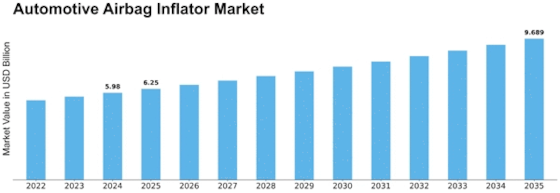

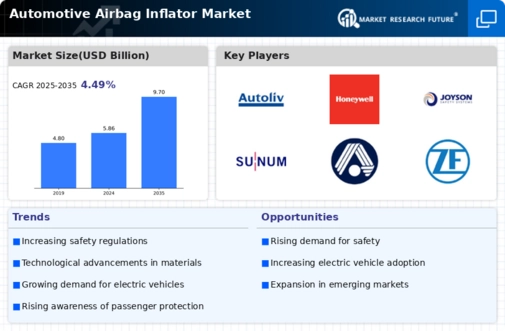
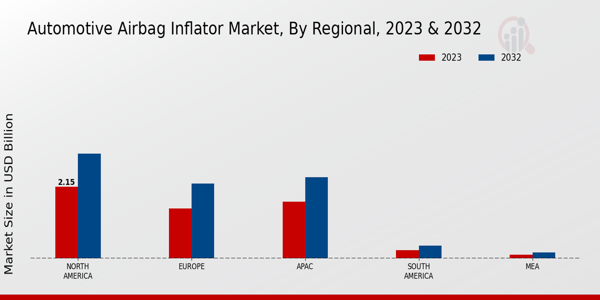
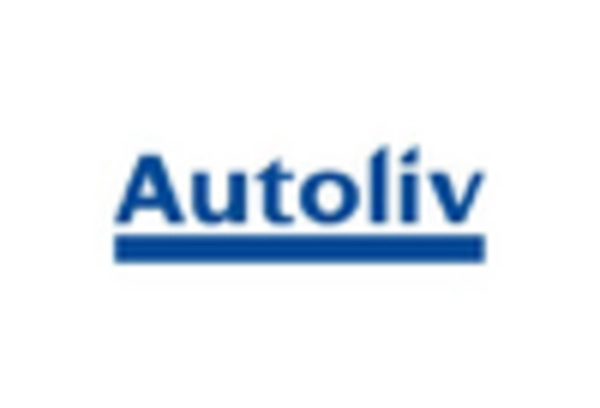


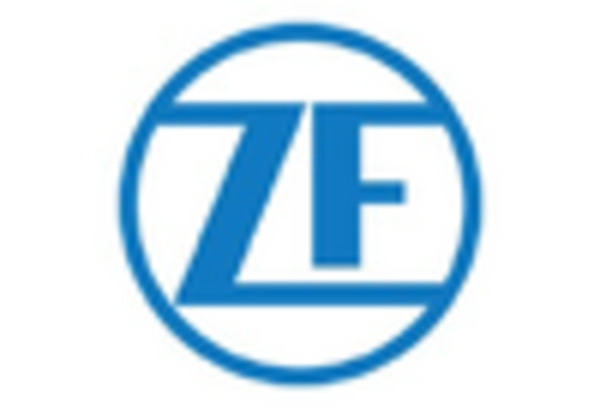
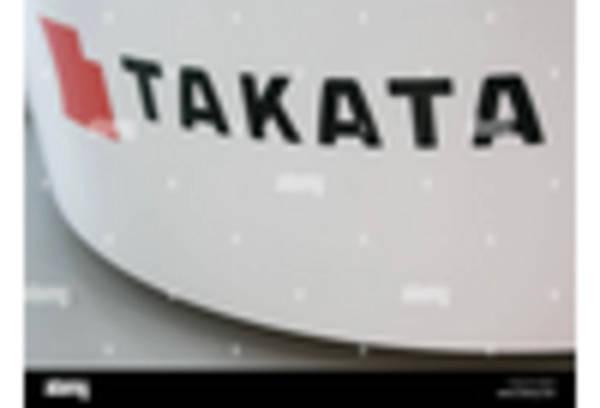


Leave a Comment